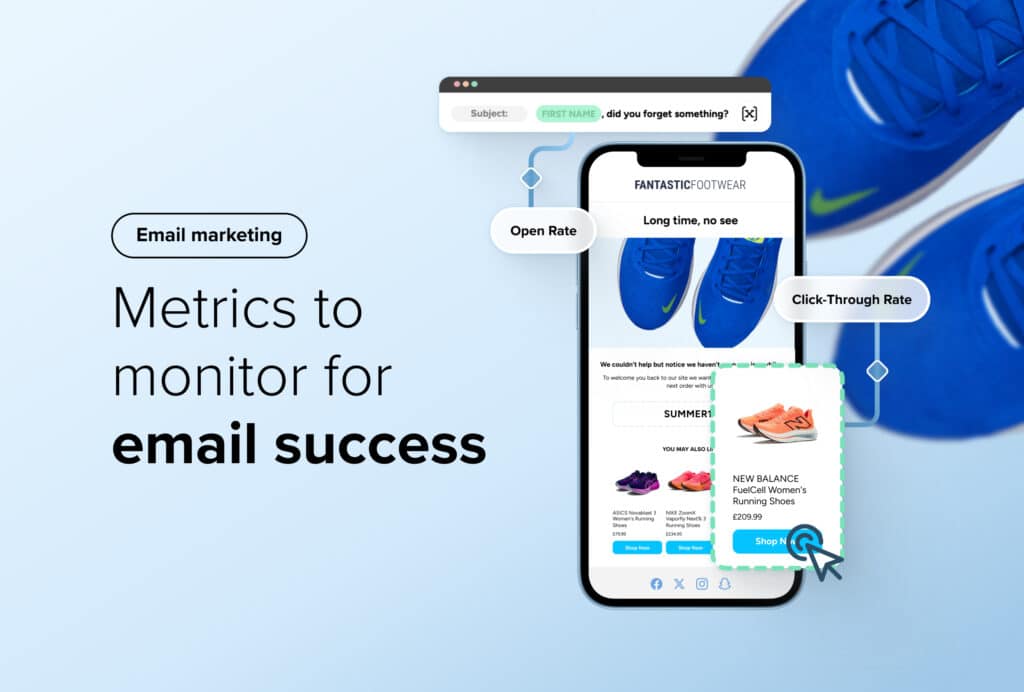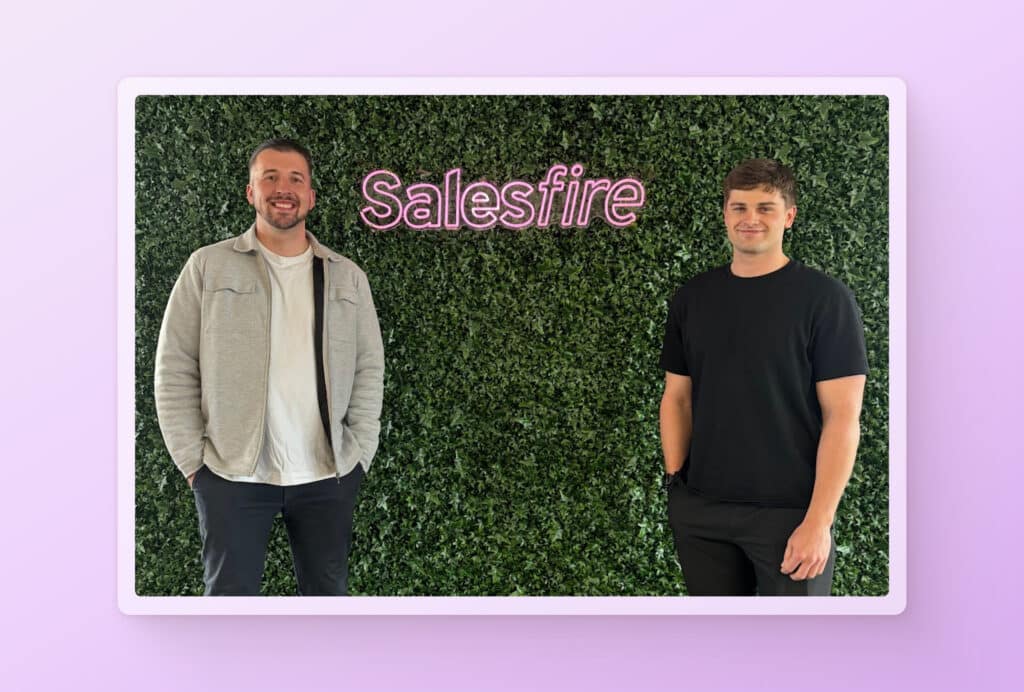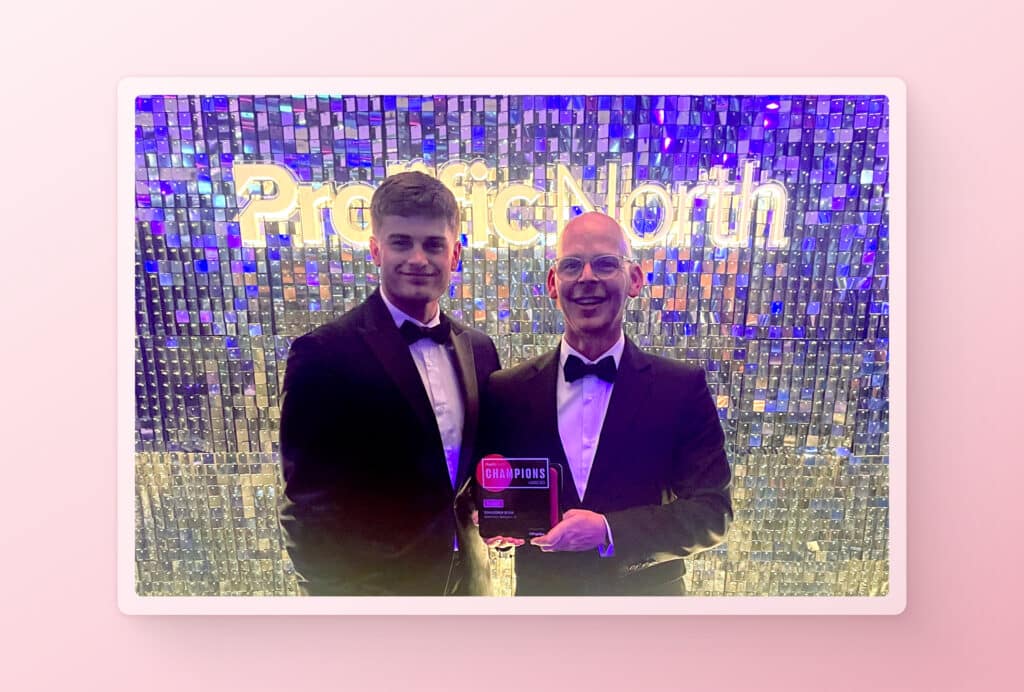Average Fashion eCommerce Conversion Rates: How Do You Hold Up Against the Competition?
By Sophie Walker • Last updated: Thursday Jul 18th, 2024
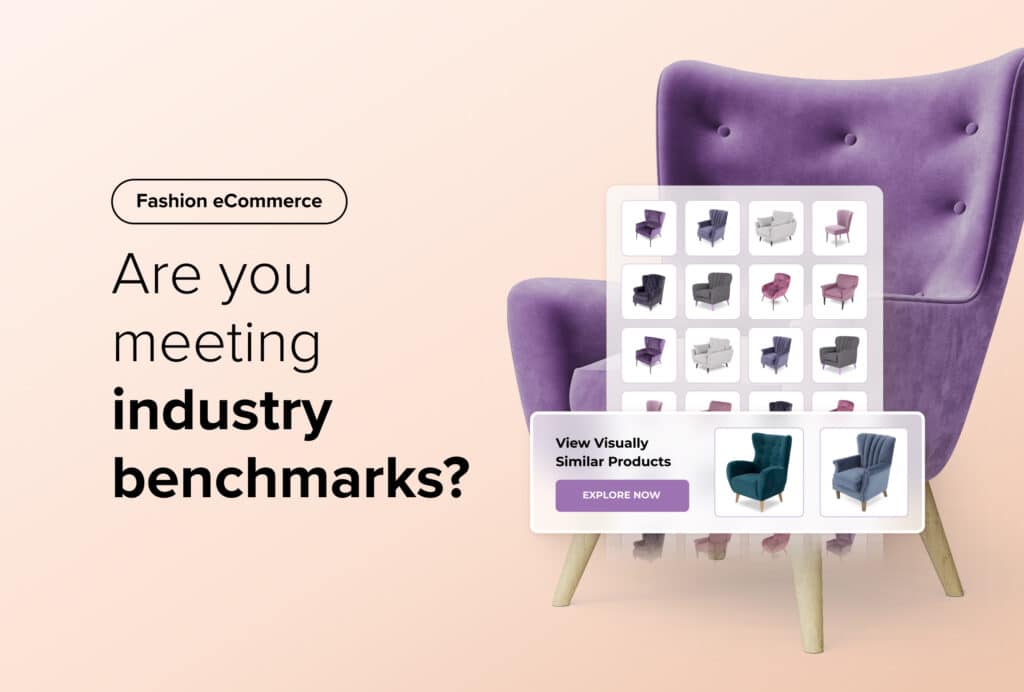
Fashion eCommerce is growing year-on-year, and data shows that the industry could be worth $1.2 trillion in 2025. 1
The increasingly fast pace of fashion means that the apparel market offers huge opportunities for eCommerce websites to find success. However, the competition is fierce, and fashion brands must work hard to keep on top of constantly changing trends.
Thanks to social media and digital trends, keeping up with the latest styles and products has become easier than ever for consumers. It’s all just a few clicks away.
And this new accessibility to fashion inspiration has meant that the industry has grown from strength to strength.
In this article, we’ll explain what the conversion rates in fashion eCommerce are, why tackling low conversion rates is important and what you can do to stay ahead of the competition.
Suggested reading: Read our free eBook, ‘Reducing Cart Abandonment in Fashion eCommerce’, to get practical tips for improving conversions and guiding shoppers to purchase.
Average fashion eCommerce conversion rates
Fashion reigns supreme as the largest sector in B2C eCommerce.2
Generally, fashion is one of the industry sectors that continually comes out on top when it comes to eCommerce performance.
Salesfire Trends data shows that the average conversion rate across the fashion industry is sitting at 5.17% over the past 12 months.
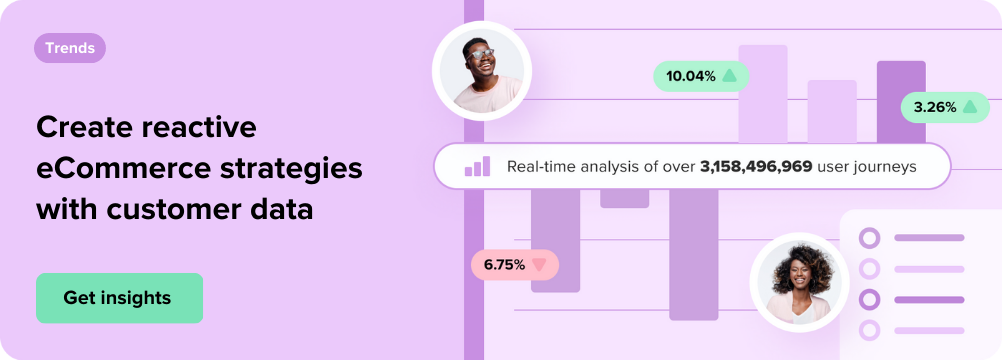
Conversion rates by industry
The fashion eCommerce conversion rate figure sits significantly higher than the average conversion rate for other prominent industries, such as home and living at 1.67%, and footwear at 2.74%.
There are many reasons why eCommerce conversion rates across fashion may sit higher than other sectors, including:
- Low-cost nature of fashion: Lower costs are normal across the fashion industry, meaning as we move through seasons and trends, shoppers can invest in new apparel more regularly for less.
- Fashion moves fast: Unlike some other industries, fashion trends move very quickly, meaning that consumers are constantly looking to buy new items and chasing to meet up with the trends.
- Accessibility: There are a plethora of fashion stores available to the online shopper, making it easier than ever to get hold of new products and try out many different stores, looking for the best deals and products.
The accessibility and quick-changing nature of fashion mean that consumers often take less time making their minds up about completing their purchases. As a result, fashion eCommerce stores typically have faster conversions and bigger opportunities for online growth.
Pro tip: As well as looking at conversion rates, big data platforms such as Salesfire Trends allow you to monitor performance indicators such as average order value, page views, and visitors, which can be used to compare and benchmark performance across industries.
How can retailers improve conversion rates in fashion eCommerce?
In today’s saturated eCommerce market, fashion retailers may have difficulty standing out and some brands may struggle to keep up with the good conversion rates that have been set as a benchmark across the fashion industry.
There is a temptation for retailers to pour all their resources into customer acquisition and increase ad spend if their website is underperforming or they have low conversion rates, in the hope that newfound traffic and site visitors will increase the likelihood of greater conversions.
While this sounds possible in theory, if the new traffic gained is then being driven to a website that isn’t optimised, the shopper may not convert to a purchase.
Brands need to think strategically and look into tactics such as conversion rate optimisation (CRO) to gain more revenue from existing website visitors and ensure conversions from new users. As you think ahead to developing a fashion CRO strategy, make sure you:
- Prioritise retention: Retaining existing customers costs less than acquiring new ones, so it is important to support returning customers and encourage repeat purchases.
- Focus on the long term: A focus on long-term optimisation can help retailers to keep up with industry conversion rate benchmarks and create more sustainable growth for their brands over a longer period of time.
- Optimise customer experiences: Whether through marketing, personalisation, or website updates, make sure that the customer experience is as seamless as possible. In fashion eCommerce, it’s especially important that shoppers can move easily between your website and social media pages to get inspiration from multiple sources.
So if your conversion rate is lagging behind and your site isn’t converting users, there are steps you can take to improve your website’s performance and get ahead of competitors.
Suggested reading: Want to learn more about CRO? Read our guide to conversion rate optimisation.

1. Integrate CRO tools
With the help of the latest tech, you can transform the efficiency of your site and maximise conversions.
Taking into consideration the complete shopping journey, CRO tools make it easier for retailers to secure more sales and provide seamless shopping experiences.
Salesfire has a complete range of conversion rate optimisation tools that work together seamlessly to enhance a website’s conversion rate.
- Recommendations: Increase product exposure and discovery by showcasing genuinely relevant, personalised recommendations on your product pages. Accelerate your user towards the checkout by effectively matching them up with their perfect purchase.
- Visually similar search: Allow users to find the products they’re looking for more easily by using an image search tool. AI-powered visual search improves overall user navigation and makes it easy for shoppers to find items that they’ve seen on social media on your fashion website.
- Search: Catapult the efficiency of your search functionality and prevent shoppers from getting frustrated with slow site speeds by connecting users with the products they’re looking for. An optimised site search tool should offer redirects and auto-query suggestions to guide shoppers to the relevant product category or item.
The integration of smart, CRO tools works to improve the user experience, streamline the browsing experience and boost sales for the long term.
Suggested reading: Read our article, ‘4 signs your eCommerce business needs CRO software’, to learn more about the importance of conversion rate optimisation in fashion eCommerce.
2. Website personalisation
Your website visitors have come to expect personalisation as a standard. This is especially true for Gen Z shoppers, 45% of whom expect personalisation when shopping online.
As fashion retailers compete for the same audiences, on-site personalisation will make your website stand out and make your shoppers feel loyal to the unique experience that you can offer them. Using eCommerce personalisation tools, you can improve conversion rates and get ahead of the competition.
Salesfire’s Digital Assistant has been designed as a complete on-site personalisation solution. It’s equipped with ready-to-deploy campaigns that respond to shoppers’ behaviour and showcase relevant messaging and incentives at exactly the right time.
Some of the Digital Assistant personalisation campaigns include:
- Recently viewed: Showcase your shopper’s previous on-site sessions and remind them of the products they loved from last time, making it effortless for them to jump back into their buying journey.
- Reserve stock countdown: Let users know that the products saved in their basket are reserved for a set amount of time, increasing the urgency in completing their purchase.
- Bespoke messaging: Display information such as delivery costs or loyalty programs at exactly the right time to prevent basket abandonment and encourage conversions. Making key information available for your shopper when they need it improves the on-site experience and removes friction from their path to purchase.
- Provide a discount incentive: Provide a timely incentive if your shoppers show signs of exit intent to guide them to complete their purchase.
Through personalisation and the integration of campaigns that respond to individual customer behaviour, you can create a flexible, intuitive shopping experience moulded towards your shoppers’ needs.
3. Create a holistic marketing strategy
In a competitive market, brands have to lean heavily on creating marketing strategies that reach the right audiences.
One of the most effective ways to ensure your efforts are successful is to take a holistic approach to your overall marketing, focused on delivering an omnichannel eCommerce strategy.
This means creating a unified approach to marketing that will help meet your brand’s objectives and address every part of the customer journey — from the minute a user discovers your brand to their repeat purchase.
You can optimise your marketing efforts by:
- Nurturing with email marketing: One of the most crucial ways to communicate with your shoppers is through email marketing. By utilising automation and creating engaging email sequences, you can nurture your new and existing shoppers into loyal brand advocates.
- Creating consistency across marketing materials: By taking the time to identify a core aesthetic, brand colours, or logo, you can make your brand easily recognisable. From landing pages to your website pages, ensuring consistency across visuals is key.
- Optimising your social media strategy: Social media allows you to build a strong brand presence, reach new audiences and facilitate social media product discovery, making it an integral part of your marketing plan. Before you develop your social media strategy, it’s important to first ensure that your website is optimised for mobile, desktops and tablets. This will mean that if a user visits your website through social media, they receive a seamless experience.
Taking the steps to optimise each touchpoint and make each marketing interaction more considered will help you to achieve your overall brand vision and improve conversions for the long run. Customers will feel that they are getting a unified, consistent experience, and will be able to easily recognise your brand amidst competitors.
Pro tip: When it comes to consistency, you can utilise the Digital Assistant ‘Traffic Source’ condition to identify where your traffic has come from. Whether it be a social media campaign or an affiliate link, you can use this data to display the on-site campaigns that are most relevant to them.
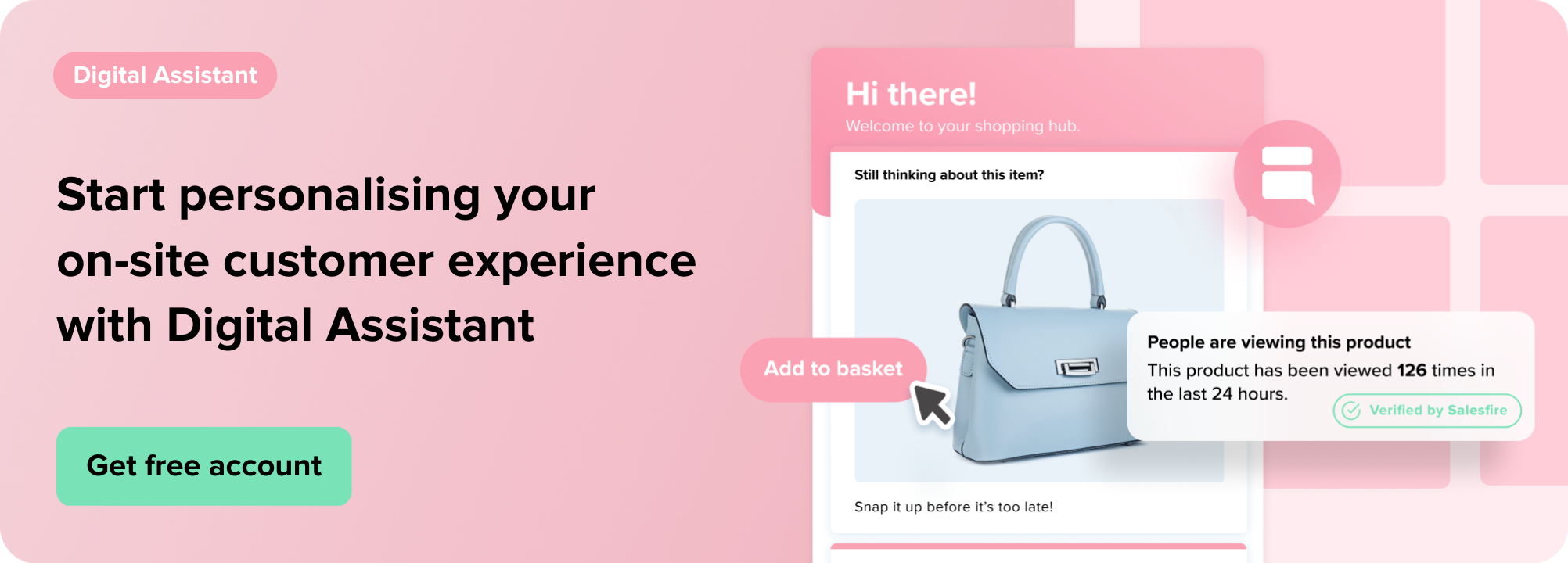
Catapult your conversion rate with Salesfire
Improving conversion rates is crucial to achieving success in a competitive fashion eCommerce space.
As fashion retailers continue to adapt their eCommerce offerings, an optimised website can help you create a streamlined user journey and get ahead of the curve.
Salesfire can help you not only meet the average conversion rates in fashion eCommerce, but go beyond them.
Our full suite of eCommerce conversion rate optimisation tools are designed to create seamless end-to-end shopping experiences. Salesfire’s software allows fashion brands to cultivate unique and user-friendly websites that keep customers coming back time and time again.
1 Fashion eCommerce market value worldwide from 2021 to 2025 – Statista
To see how Salesfire can help you optimise your conversion rate, email one of our experts at enquiries@salesfire.com or book a free demo of our personalisation tools.

